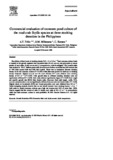Commercial evaluation of monosex pond culture of the mud crab Scylla species at three stocking densities in the Philippines.
- Global styles
- MLA
- Vancouver
- Elsevier - Harvard
- APA
- Help

ดู/
วันที่
1999Page views
1,818ASFA keyword
AGROVOC keyword
Taxonomic term
เมตาดาต้า
แสดงระเบียนรายการเต็ม
Share
นามธรรม
The effects of three levels of stocking density (0.5, 1.5 or 3.0 m−2) and monosex culture (male or female) on the growth, apparent feed conversion ratio (FCR), survival, and production of mixed species of mud crabs, Scylla serrata and S. tranquebarica, were investigated. The juvenile crabs were stocked in 150 m2 earthen ponds with Gracilariopsis bailinae as shelter and fed a mixed diet of 75% fresh mussel flesh and 25% fish bycatch. There was no interaction between stocking density levels and monosex culture (P<0.05) so that data were pooled for each sex or stocking density treatment. Highest survival and the most efficient FCR were obtained from stocking density of 0.5 m−2 (P<0.05). Crab growth rates in different stocking densities were not significantly different (P>0.05). Male crabs attained significantly higher (P<0.05) final weight and specific growth rate (SGR) than female crabs. However, final crab length, width, FCR, survival, and production were not significantly different between male and female crabs (P>0.05). Highest return on investment (ROI) and lowest production cost were obtained from 0.5 m−2. Partial budgeting analysis showed that no net benefit accrued from stocking beyond 1.5 m−2. Both male or female monosex cultures gave high net revenue and ROI of more than 100%. Results suggest that the culture of male or female mud crabs at 0.5–1.5 m−2 is economically viable but male monosex culture is more profitable.
การอ้างอิง
Triño, A. T., Millamena, O. M., & Keenan, C. (1999). Commercial evaluation of monosex pond culture of the mud crab Scylla species at three stocking densities in the Philippines. Aquaculture , 174(1-2), 109-118. https://doi.org/10.1016/S0044-8486(99)00002-2
Type
ArticleISSN
0044-8486คอลเลกชัน
- Journal Articles [1258]
Related items
Showing items related by title, author, creator and subject.
-
[The Philippines recommends for mangrove crab:] Biology of mangrove crab
The Mangrove Crab Technical Committee 2018 (DOST-PCAARRD, 2021) -
Development of protocol for the production of hatchery-reared mud crab Scylla serrata juveniles for soft-shell crab farming
Quinitio, Emilia T. ; Libunao, Gardel Xyza; Parado-Estepa, Fe D. (Aquaculture Department, Southeast Asian Fisheries Development Center, 2017)
Development of economically viable techniques for growing hatchery-reared juvenile crabs to suitable sizes will address the problem on the source of seed stocks for soft-shell crab farming. This paper reports the production ...
; Libunao, Gardel Xyza; Parado-Estepa, Fe D. (Aquaculture Department, Southeast Asian Fisheries Development Center, 2017)
Development of economically viable techniques for growing hatchery-reared juvenile crabs to suitable sizes will address the problem on the source of seed stocks for soft-shell crab farming. This paper reports the production ... -
Larval rearing of mud crab (Scylla): What lies ahead
Waiho, Khor; Fazhan, Hanafiah; Quinitio, Emilia T. ; Baylon, Juliana C.; Fujaya, Yushinta; Azmie, Ghazali; Wu, Qingyang; Shi, Xi; Ikhwanuddin, Mhd; Ma, Hongyu (Elsevier, 2018)
The increasing global demand for mud crabs (genus Scylla) and threats to the wild populations highlight the urgency of fully rearing them in captivity. Despite considerable progress in mud crab production, most crab farms ...
; Baylon, Juliana C.; Fujaya, Yushinta; Azmie, Ghazali; Wu, Qingyang; Shi, Xi; Ikhwanuddin, Mhd; Ma, Hongyu (Elsevier, 2018)
The increasing global demand for mud crabs (genus Scylla) and threats to the wild populations highlight the urgency of fully rearing them in captivity. Despite considerable progress in mud crab production, most crab farms ...





